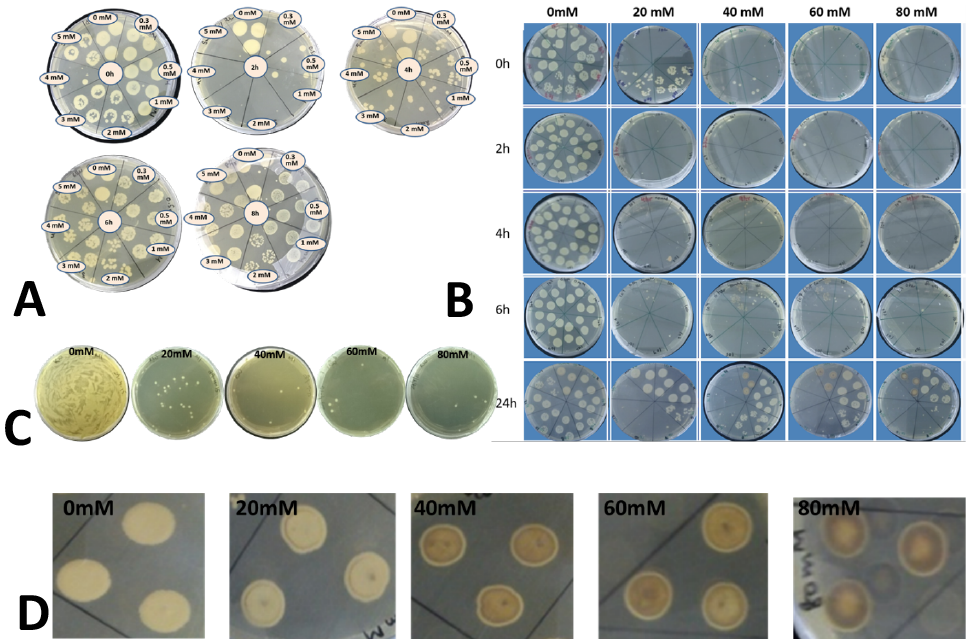Copper Stress-Induced Transcriptional Regulatory Protein CusR also Regulates Silver Efflux in Klebsiella pneumoniae KW
Copper Stress-Induced Transcriptional Regulatory Protein CusR also Regulates Silver Efflux in Klebsiella pneumoniae KW
Maimoona Imran2, Farah Rauf Shakoori2*, Soumble Zulfiqar1,
Abeedha Tu-Allah Khan1 and Abdul Rauf Shakoori1*
Effect of Ag+ on growth of Klebsiella pneumoniae KW and metal uptake. (A) Ag (0.3-5mM) was added in log phase cells and 5µl was spotted with 2h time intervals. Addition of the metal appeared to be highly toxic and strength of colonies decreased with increasing concentration at time 0 and no visible growth at 2hs. Growth reinitiated at 4 h that increased afterwards. (B) Addition of higher concentrations caused further delay and it took 6 h for cells to adapt and growth reinitiation. (C) Spreading of 100µl at 2h post metal addition showed the presence of small number of alive cells. (D) Brown coloration of colonies show silver accumulation in the cells.
Expression and purification of CusR. A, total cell lysate (T), supernatant (S) and pellet (P) of un-induced and 0.1mM IPTG induced transformants grown at 37 °C. B, total cell lysate (T), supernatant (S) and pellet (P) of induced transformants, first given heat shock and then grown at 20 °C. C, dialyzed sample and FPLC fractions of CusR; dialysed sample (D), washout (W), Flow through (F), filtered sample (Filt). The subsequent lanes show FPLC fractions. Lane M: Bench mark protein unstained ladder.
4%-PAGE to show DNA-Protein interaction (Gel shift assay). Lane 1: the amplified bidirectional cusRS promoter (Prom), Lane 2: DNA Ladder Mix (SM006), Lane 3: BSA + cus promoter, Lane 4: promoter bound to CusR. Below it is shown multiple alignment of promoter cusRS sequence from K. pneumoniae KW, K. pneumoniae HS11286 (CP003785.1), K. pneumoniae NTUH-K2044 (AP006725.1), K. aerogenes KCTC 2190 (FO203355.1), K. variicola At-22 (CP001891.1), Raoultella ornithinolytica strain 18 (CP012555.1), and Citrobacter freundii strain P10159 (CP012554.1). Figure shows palindromic sequence of CusR binding box (Green color box), -10 box (yellow color box), -35 box (pink color box) conserved among different species of family Enterobacteriaceae. A/G in red font represents predicted transcription start site.
Effect of Ag+ (1-5 mM) on transcription of cus and cue genes. (A) Expression of cusCFBA and cusRS was upregulated in the presence of 1mM Ag+ that increased with higher concentrations of Ag+ upto 3mM. However, further increase in the metal resulted in lesser upregulation. (B) Transcription of cue regulon genes (copA, cueO and cueR) also upregulated in the presence of Ag+. In this case, maximum upregulation was observed at 1mM Ag. cue regulon was found to be 6 times more upregulated as compared to cus regulon in response to the metal.
CusR protein-protein interaction analysis through STRING server shows its major role in copper homeostasis (via Cus, Cue and Cut factors) in addition to regulation and sensing of some other heavy metals (via zraS) as well as starvation (via rspR).
Proposed growth trend of K. pneumoniae KW against increasing concentration of silver.
Suggested functional model of Cus Regulon. The transmembrane efflux channel CusCBA consists of CusA, inner membrane protein; CusC, outer membrane protein and CusB, membrane fusion protein. CusF, a metallochaperone in periplasm, binds Ag+ and brings it to the efflux channel. The regulatory component of cus regulon CusRS which is a two-component regulatory system consists of CusS, sensor kinase and CusR, response regulator. The Cus regulon is activated in the presence of metal ions (Ag+, Cu++, Au+), for which CusS is auto-phosphorylated in the presence of metal ion (in this case Ag+) and trans-phosphorylates CusR, which binds with bidirectional cus promoter to activate RNA polymerase and transcription factor complex (adapted from Kim et al., 2011).
















